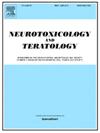双酚a对加压素调节海马突触可塑性的影响。
IF 2.8
3区 医学
Q3 NEUROSCIENCES
引用次数: 0
摘要
神经肽精氨酸加压素(AVP)在海马中通过调节神经元兴奋性、突触可塑性等过程发挥重要作用。AVP的活性受性激素的调节。本研究探讨了环境内分泌干扰物双酚a (BPA)对AVP调节海马突触可塑性的影响。AVP 10-100 nM显著增加体外海马神经元树突复杂性和树突棘密度,AVP受体1a (V1aR)拮抗剂(RG7713)或催产素受体(OTR)拮抗剂(L368-899)可部分消除AVP复杂性和树突棘密度。10 nM BPA增加了神经元树突复杂性和脊柱密度,雌激素受体(er)拮抗剂(ici182780)部分消除了这一作用,但雌激素受体和ERRγ拮抗剂(他莫昔芬)完全消除了这一作用。10 nM BPA不影响AVP(100 nM)对树突复杂性和脊柱密度的影响,但消除了DHT + AVP对树突复杂性的促进作用。1000 nM BPA不仅能抑制树突复杂性,还能消除AVP、17β-雌二醇(17β-E2) + AVP和11-酮二氢睾酮(DHT) + AVP对树突复杂性的促进作用。此外,BPA在1000 nM时下调了V1aR和OTR蛋白的表达水平。同时,BPA在10 nM时促进了海马片CA2对LTP的维持,但BPA联合处理消除了17β-E2或DHT对LTP的影响。BPA(10 nM)不影响AVP对长期增强(LTP)的促进作用,但消除了DHT + AVP对LTP的促进作用。这些结果表明,纳米摩尔水平的BPA主要通过破坏17β-E2和DHT对AVP活性的影响来影响AVP,从而调节海马树突形态的改变和突触的可塑性。本文章由计算机程序翻译,如有差异,请以英文原文为准。
Effects of bisphenol-a on vasopressin regulating synaptic plasticity of hippocampus
The neuropeptide arginine vasopressin (AVP) plays an important role in the hippocampus by regulating neuronal excitability, synaptic plasticity, and other processes. Activity of AVP is regulated by sex hormones. The present study investigated the effects of bisphenol-A (BPA), a environmental endocrine disruptor, on AVP regulating synaptic plasticity of hippocamus. AVP at 10–100 nM significantly increased the dendrite complexity and dendrite spine density of hippocampal neurons in vitro, which was partially eliminated by AVP receptor 1a (V1aR) antagonist (RG7713) or oxytocin receptor (OTR) antagonist (L368–899). BPA at 10 nM increased neuronal dendritic complexity and spine density, which was partially eliminated by estrogen receptor (ERs) antagonist (ICI182,780) but completely abolished by antagonist of both ERs and ERRγ (Tamoxifen). BPA at 10 nM did not affect the effect of AVP (100 nM) on the dendrite complexity and spine density, but eliminated the promoting effects of DHT + AVP on the dendritic complexity. BPA at 1000 nM not only inhibited the dendritic complexity but also eliminated the promoting effects of AVP, 17β-estradiol (17β-E2) + AVP, and 11-ketodihydrotestosterone (DHT) + AVP on the dendritic complexity. In addition, BPA at 1000 nM down-regulated the levels of V1aR and OTR protein expressions. Meanwhile, BPA at 10 nM promoted the maintenance of LTP of CA2 in the hippocampal slices, but co-treatment of BPA eliminated the effect of 17β-E2 or DHT on LTP. BPA (10 nM) did not affect the promotion of long-term potentiation (LTP) by AVP, but eliminated the promotion of LTP by DHT + AVP. These results suggest that BPA at nanomoles levels affected AVP regulating modification of dendrite morphology and synaptic plasticity of hippocampus mainly by disrupting the effects of 17β-E2 and/or DHT on AVP activity.
求助全文
通过发布文献求助,成功后即可免费获取论文全文。
去求助
来源期刊
CiteScore
5.60
自引率
10.30%
发文量
48
审稿时长
58 days
期刊介绍:
Neurotoxicology and Teratology provides a forum for publishing new information regarding the effects of chemical and physical agents on the developing, adult or aging nervous system. In this context, the fields of neurotoxicology and teratology include studies of agent-induced alterations of nervous system function, with a focus on behavioral outcomes and their underlying physiological and neurochemical mechanisms. The Journal publishes original, peer-reviewed Research Reports of experimental, clinical, and epidemiological studies that address the neurotoxicity and/or functional teratology of pesticides, solvents, heavy metals, nanomaterials, organometals, industrial compounds, mixtures, drugs of abuse, pharmaceuticals, animal and plant toxins, atmospheric reaction products, and physical agents such as radiation and noise. These reports include traditional mammalian neurotoxicology experiments, human studies, studies using non-mammalian animal models, and mechanistic studies in vivo or in vitro. Special Issues, Reviews, Commentaries, Meeting Reports, and Symposium Papers provide timely updates on areas that have reached a critical point of synthesis, on aspects of a scientific field undergoing rapid change, or on areas that present special methodological or interpretive problems. Theoretical Articles address concepts and potential mechanisms underlying actions of agents of interest in the nervous system. The Journal also publishes Brief Communications that concisely describe a new method, technique, apparatus, or experimental result.

 求助内容:
求助内容: 应助结果提醒方式:
应助结果提醒方式:


